 Sheep Sorrel (Rumex acetosella)is an introduced species with arrowhead shaped leaves that spreads by underground runners. The female flowers (there are separate male and female plants) are burgundy red and the plant is not unattractive when in bloom. It is a very adaptable species, and grows in a wide variety of habitats. Here it grows in cracks in the bedrock in our Garry Oak meadow. The leaves are edible, and lemony-tart and make a good addition to a salad, soup or as a component of a salad dressing. Note however that they are high in oxalic acid, which is toxic in large quantities, so use in moderation. Other common names include Red Sorrel, Common Sorrel and Field Sorrel.
0 Comments
Baldhip Rose is the commonest wild rose on the property at Leaning Oaks. It is unusual for a rose in that is a shade tolerant species. Most roses retain the sepal crown on the bottom of the fruit (in the same way that an apple does), but this species drops this appendage and the small pear shaped fruit is smooth. The latin name, Rosa gymnocarpa refers to this; gymnocarpa means "naked fruit". The leaves can be used to make a rose tea.
Robert's Geranium (Geranium robertianum) is an introduced herbaceous weed. It is probably best known for its bright pink flowers and distinctly unpleasant smell if the foliage is crushed or bruised (earning it another common name, "Stinky Bob"). It is rumoured to be edible and has been used for a variety of medicinal uses, although at least one website cautions that there has been very little testing of side effects. It is one of the few non-native plants which can invade shady forests and I have seen it moving into some of the older forests on southern Vancouver Island.
Geranium is greek for "little crane's bill", in reference to the shape of the fruit.  Fringecup is one of my favourite native plants. The lush basal rosette and strange recurved, filigree petals are subtle, unusual and elegant. It is, however, the perfume that these flowers produce that makes Tellima grandiflora so rewarding. This perfume brings back strong memories of my days as a park naturalist. The hill behind the visitor centre at Goldstream Provincial Park was covered in Fringecup and its perfume was a fixture during the busy days of spring school programs. Fringcup is a member of the saxifrage family and it is the only species in the genus. This makes the latin name (which means large flowered Tellima) sort of silly, since there is only one kind of Tellima.  It is the two opposite leaves that are joined together forming a shallow cup that make this plant distinct. Other than that it can be quite variable depending on the moisture and soil conditions. Claytonia perfoliata ssp. perfoliata is edible and makes a bright addition to salads or anywhere that greens are desired.  A little way from the meadow, in dappled shade and often near the base of a Douglas-fir, Trientalis borealis ssp. latifolia sports a starry flower on a oh so slender stalk--the flower appearing to float above the broad leaves. Indian Potato, another English name refers to the small, elongate pink tubers that were gathered for food by the First Nations. They are apparently a good source of starch. I am going to have to remember to go out and photograph the seed capsule - the description is that it looks like a little tiny soccer ball.  Orange Honeysuckle (Lonicera ciliosa) is one of two species of Lonicera that we have at Leaning Oaks. It is the earlier blooming of the two. Unlike moth pollinated honeysuckles, our native honeysuckle vines are pollinated by hummingbirds, and their showy flowers and large nectaries (but no perfume) are typical of hummingbird pollinated flowers. It is one of the few native vines in our area, and can climb up into the canopy of small trees. Here they grow up Garry Oaks and small Douglas-fir trees. One of the emblematic wildflowers in the Garry Oak meadow is Camassia quamash. The blue swaths begin sometime near the end of April and are usually finished by the May long weekend. The bulbs were a very important traditional food . Carbohydrates were in short supply and the bulbs were a coveted source. Fields of camas were passed on between families, the death camas "weeded" out and the ground cleared of rocks, sticks and other debris to provide the best growing conditions. The bulbs have to be cooked for long periods of time to break down the long chained inulin into something that can be digested.
It is interesting that this quote from Lewis (of Lewis and Clarke) was mid June; long after our camas have dropped all of their "blumes".
 I have this image of a game of Russian Roulette where there are people out harvesting the rich bulbs of the edible blue camas and never quite knowing when they may accidentally dig up the the similar Toxicoscordion venenosum bulb that grows in the same locations, but contains the alkaloid zygacine. To avoid this, local indigenous people would remove the plants from a local harvest area when they were in bloom and more recognizable. This would make harvesting less risky! The leaves are also poisonous and have been deadly to grazing cattle in the spring where the death-camas is out before other forage is available. We have a few locations where the creamy death-camas is a lovely counterpoint to the abundant blue camas; generally in slightly moister areas.  Bur Chervil (Anthriscus caucalis) is an introduced weed, similar to the garden herb, It is an aggressive colonizer in the meadow. It is a handsome plant, with fine, fern-like foliage with a strong smell when bruised or cut. The flowers are small and white. The plants here show an amazing diversity of sizes, from just a few inches high on trampled or drier sites with thin soils to robust plants over a meter high on moister, deeper soils. For the most part it seems to behave as a biennial here, forming a basal rosette the first year and flowering in the spring of the second year. |
AuthorsTwo biologists on a beautiful property armed with cameras, smart phones and a marginal knowledge of websites took up the challenge of documenting one species a day on that property. Join along! Posts and photographs by Leah Ramsay and David Fraser (unless otherwise stated); started January 1, 2014. Categories
All
Archives
January 2025
|




 RSS Feed
RSS Feed